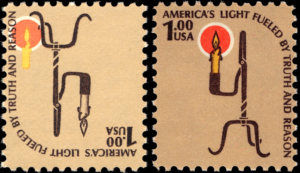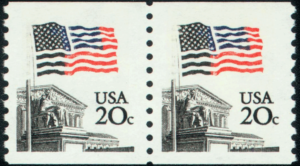[Note: Click on any image for a larger version.]
The Basics of Mistakes In Stamps
By John M. Hotchner
The theme for this column might well be Murphy’s Law: “Whatever Can Go Wrong Will.” Then there is Murphy’s Corollary that says: “Murphy was an optimist.”
 Errors, Freaks and Oddities — EFOs for short — are the production varieties that are the natural result of every printing operation, be it of stamps, currency, newspapers, lottery tickets, or stock certificates.
Errors, Freaks and Oddities — EFOs for short — are the production varieties that are the natural result of every printing operation, be it of stamps, currency, newspapers, lottery tickets, or stock certificates.
Presses and printing jobs have to be tested. The elements of printing and finishing into post office products have to be synchronized. Presses have to be turned on and turned off — sometimes automatically in the midst of a job when problems arise. Plates have to be inked, wiped, and cleaned. Paper has to be spliced. Ink lots have to be mixed and matched. And in all these processes and many others, things can go wrong.
When they do, then other processes kick in to make sure that imperfect or incomplete product is identified, rejected, accounted for and destroyed. But even here, things can go wrong. And the more automated the system — the more bells and whistles it has — just like your new car with all its fancy computerized features, the more likely that something will go wrong.
This has been especially true for American stamp printers when new presses and processes are being run in.
Is it any wonder that there are production varieties for us to collect!? The wonder is that there is not more of it.
If you have had the chance to stand and watch the presses in operation as I have, you will be familiar with the bins of waste that is generated in the printing process. The trick for security printers is to identify it all and dispose of it before it reaches the public. Given the billions of stamps produced in very short time spans, they actually do a remarkable job of limiting EFO material that reaches our collections. This is one of the reasons we covet EFOs. Most are anything but common.
What are EFOs? Let’s do a bit of defining, before we go any further. EFO collectors like to categorize the objects of our affection, and it can be important to do so, as definitions lead to collecting categories, and have an impact on value.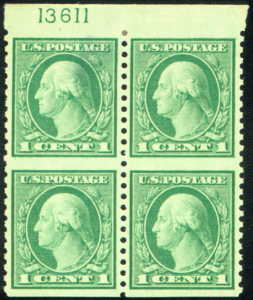
Errors and Freaks are by definition “mistakes” or “varieties,” but not all are created equal. Most “ERRORS” (as a term of art) have higher value than most “FREAKS.” ERRORS are major, exactly repeatable, and total. See Figure 1 on the right for the horizontally-imperforate Sc. 538c. This would include imperforate stamps, missing colors, inverts, full pairs with gutter between, incorrect colors, wrong watermarks or watermarks where there should not be any. You will recognize these as being the kinds of varieties that are listed in catalogues.
“FREAKS” on the other hand tend to be more minor: misperfs [incorrect perforations], 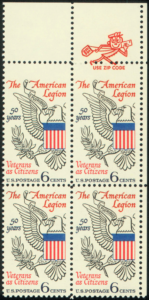 disappearing or color misregistrations, paper creases and folds that vary by degree, miscuts, and dozens of other problem children that can be created in a complex, high speed printing operation. See Figure 2 on the left for a Sc. 1369 misperf with the top row of perforations set too high. These will not be listed in the catalogues. But sometimes they will be found in combination with Errors – a transition strip for instance where the press is running out of ink, or the perforator is disengaged in the midst of a run.
disappearing or color misregistrations, paper creases and folds that vary by degree, miscuts, and dozens of other problem children that can be created in a complex, high speed printing operation. See Figure 2 on the left for a Sc. 1369 misperf with the top row of perforations set too high. These will not be listed in the catalogues. But sometimes they will be found in combination with Errors – a transition strip for instance where the press is running out of ink, or the perforator is disengaged in the midst of a run.
“ODDITIES” as a class are the strange and unusual, but usually track to normal production of flawed or odd material. Examples would be plate varieties, proofs and essays, intentionally created errors, counterfeits, and other categories. A postally-used copy of the never-issued H 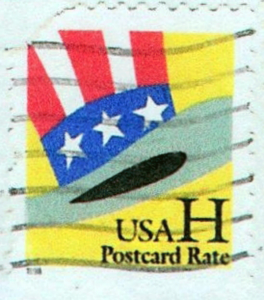 stamp is shown in Figure 3 on the right.
stamp is shown in Figure 3 on the right.
If you would like to see a much more comprehensive listing of what varieties fit under the E, F and O categories, I would refer you to the excellent website of the Errors, Freaks, and Oddities Collectors Club, www.efocc.org.
One word of caution before we go further. We must acknowledge that “One man’s eagle is another man’s turkey.” Take misperfs as an example. One collector may get truly excited to find a 10% misperf on a given stamp. Another collector looks at the same specimen and sees only a damaged or poorly perforated stamp, unworthy of his collection. So, onward …
Most collectors of EFOs don’t think of themselves as EFO collectors. Rather they add interesting material to their normal collection when they see it. Except for something 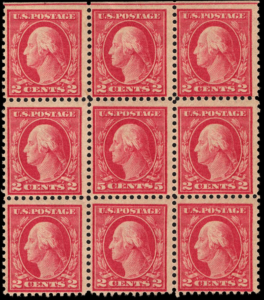 with a major catalog number such as the 5c carmine error of the 1917 Washington Head series (Scott #505, shown on the left) they don’t actively seek out an EFO unless there is an album place for it.
with a major catalog number such as the 5c carmine error of the 1917 Washington Head series (Scott #505, shown on the left) they don’t actively seek out an EFO unless there is an album place for it.
But there is a dedicated group of EFO collectors who find the subject fascinating as exemplars of what can go wrong in the printing and finishing processes. Some of us collect everything we can lay our hands on. Others will specialize in a specific category, for example: material having to do with perforations and roulettes, material reflecting problems in color and ink, or paper problems centering on folds and creases. Some limit their collections to catalog-listed errors. Others (myself included) find the most minor of freaks interesting for what they tell us about production methods.
A core group of us formed the EFO Collectors Club in 1978, and it remains a source of information and material through its quarterly journal The EFO Collector, and auction. I’d especially like to mention Wayne Youngblood, our president, Cemil Betanov, our journal editor and vice president; David Hunt, our auction director and treasurer, and Scott Shaulis, our secretary.
The United States Stamp Society is also active in this field, and its monthly journal, The United States Specialist, often carries articles of interest to EFO collectors.
Where do you find EFOs? I like to think of the answer as being in two categories: Before and After philatelic discovery. Another way to look at this is Before or After premium value
is tacked on to the find.
In the “Before” category, I would include what you might find among the stamps you buy at a post office, either across the counter in the form of sheets, booklets, or sealed rolls, or from dispensing machines. It is always our hope that lightening will strike and a clerk will hand us a sheet of missing colors.
It has happened. But usually because the clerk has no idea there is anything wrong. Most USPS staff are not stamp collectors, but if they notice something amiss, standing orders are to turn it in. I once stood behind a gentleman who was irate in handing over a roll of coils saying to the clerk “These are no good. The holes are gone so I can’t get them apart. Give me some good ones!”
Another “Before” category is, surprisingly, in collections, dealer stocks, in trade and in mixtures. It is amazing how many hands an EFO item might go through before its intrinsic “specialness” is recognized by someone who knows what he or she is looking at.
After philatelic discovery is when you find EFOs properly identified for sale by dealers, in auctions, or by collectors.
For those with an eye for modern-era US EFO material, you might wonder why you seem to see so much of it. As noted earlier, there isn’t all that much, but it tends to be found in large multiples (a sheet, a coil roll, a series of booklets coming from a dispenser), and the only way large multiples can be sold is through the very few dealers who specialize in EFOs and have built a client base of collectors who will buy them.
Finders are referred and referred until they reach one of those dealers who as a result are able to advertise significant quantities in their auctions and price lists. For 40 years, Jacques Schiff was the leading dealer/auctioneer in this field. And in that time he sold and resold many of the same lots as collectors entered and left the market.
The best reference for scarcity is the Scott Catalogue of Errors on US Postage Stamps, originated by the late Stephen Datz. Not only does it list and price US Errors, but it gives specific figures for numbers of known copies.
How are values set? Values develop from a combination of four factors:
- How near to discovery the sale takes place, and how many more are subsequently discovered. Obviously the price will drop, the more are discovered. But the seller who sells early is taking a chance because no more may be discovered, and the initial selling price may prove to have been extremely conservative.
- Supply and Demand. While this is in some respects obvious, a dealer buyer has to gauge how many ready potential customers there are so the initial investment can be returned, leaving additional copies to be sold over time, at a profit. In general, a dealer will offer for a sheet or roll in the neighborhood of about one-fourth to one-third of what he calculates the retail will be.
- How visual is the item. Missing tagging is a blue-blooded error, catalogue listed, but there are a limited number of collectors who seriously collect what they can’t easily see. Such errors can be easily outstripped in price by a colorful freak, a visually attractive freak with perforations going every which way, or one with colors disappearing.
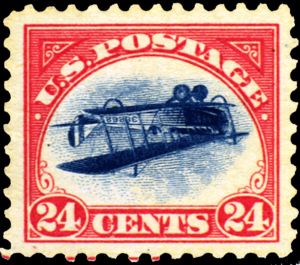 EFOs that have acquired a pedigree, even though they may not be rare. Our inverted Jenny (Sc. C3a) is a fine example. The CIA “Candleholder” Invert is another. There are near 100 copies of each. But the lore surrounding these stamps makes them a magnet for a much wider cohort than just EFO enthusiasts.
EFOs that have acquired a pedigree, even though they may not be rare. Our inverted Jenny (Sc. C3a) is a fine example. The CIA “Candleholder” Invert is another. There are near 100 copies of each. But the lore surrounding these stamps makes them a magnet for a much wider cohort than just EFO enthusiasts.
Finally, a word of caution: Where there is value, there are fakes, and even genuine stamps offered as something they are not. Your best defense is to find and use a good expertizing service that can verify claimed EFO material before you write checks. Maybe even better is self-education, which includes
- Read widely in the field. There are several excellent books, starting with Fundamentals of Philately by L.N and M. Williams. I can provide a list of useful books for anyone interested. But also keep up with the news of the field in the EFO Collector and The United States Specialist.
- Read the philatelic press, other specialist society literature, and auction catalogues, and maintain a clipping file.
- Learn through experience to distinguish what you can validate on sight and what needs to have a certificate of authenticity.
In summary, EFO collecting is not just fascinating, it is CHALLENGING, and gives you a window on stamp production – and the stamps themselves are fun to show off to other collectors. In fact, unlike most of your normal collections, EFOs can even fascinate friends and family!
Should you wish to comment on this editorial, or have questions or ideas you would like to have explored in a future column, please write to John Hotchner, VSC Contributor, P.O. Box 1125, Falls Church, VA 22041-0125, or email, putting “VSC” in the subject line.
Or comment right here.

